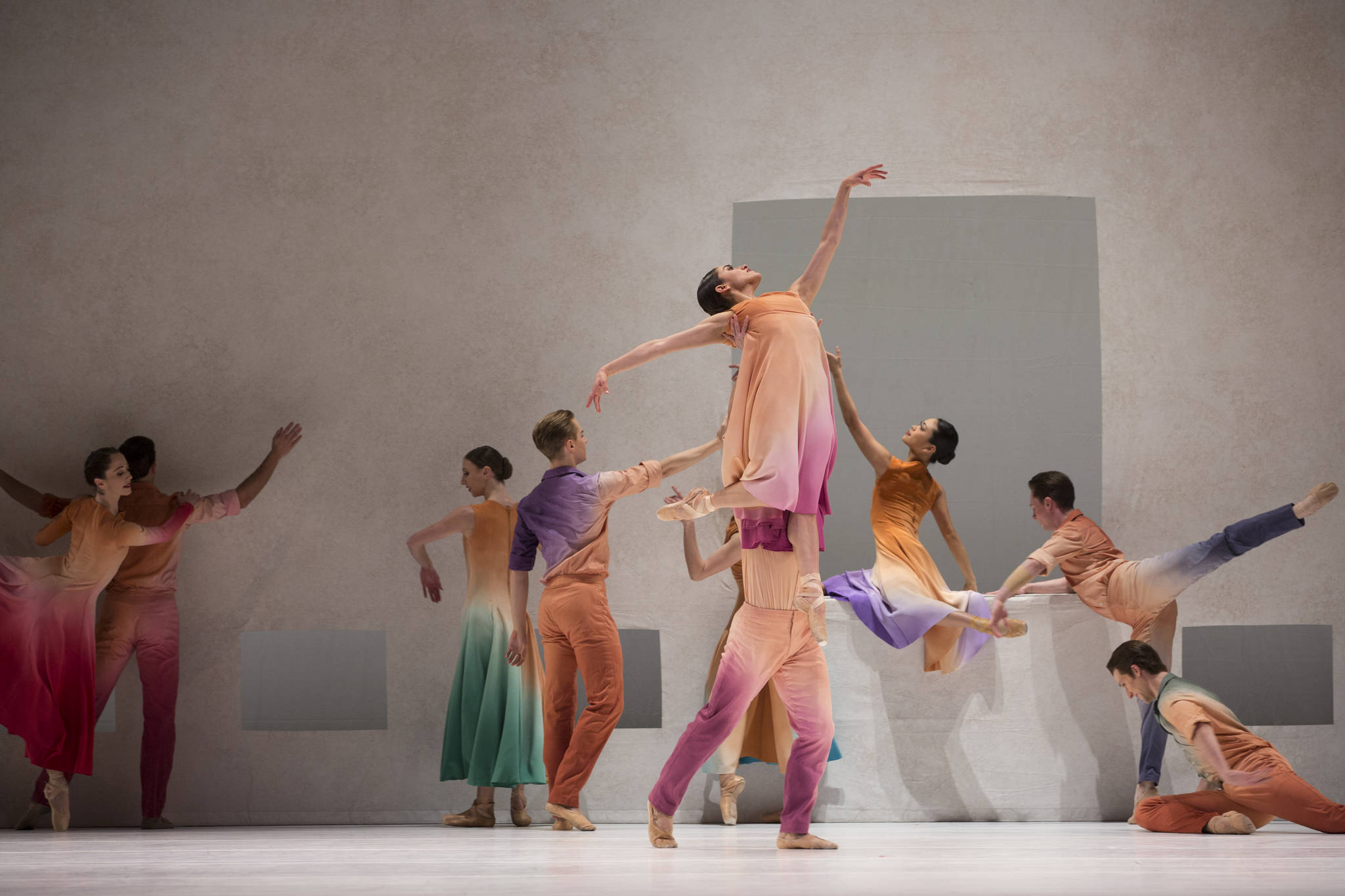While it’s true that every work at Pacific Northwest Ballet is chosen by artistic director Peter Boal, he often uses the “Director’s Choice” program to show us something new or unusual. This year’s edition includes two works illustrating the current direction of classical ballet, and a third that’s more of an outlier, bringing other traditions into the studio.
Empire Noir is, as the title suggests, an ominous work. We know choreographer David Dawson from his ebullient A Million Kisses to My Skin, and while this new-to-us ballet is full of the same kind of daredevil technical skills, he is mining a much darker vein here. The stage is carved through with a curved wall that looks like a parabola tipping over—it frames much of the action but also limits where dancers can go. Despite these boundaries, the opening-weekend cast rocketed through the space in an ensemble work filled with challenge. Dawson pulls George Balanchine’s neoclassical outlines even further into space, torquing the body and using the limbs to create momentum as dancers travel across the stage. Using a percussive score by Greg Haines, the choreographer has made a work full of fast changes, shifting groupings, and innovative partnering. At one moment Jerome Tisserand swings Leta Biasucci up into a lift as they’re traveling—the result seems to follow the curve of the set as it doubles back on itself. From there she adds momentum to the action by snapping her legs in, like a figure skater in a series of fast spins. Throughout the ballet people run in from offstage to arrive just in time to catch their partner or join a fast-moving pattern, only to polish it off and swagger away. Empire Noir is a work of significant intensity, danced with incredible focus.
Dawson spent several years dancing for William Forsythe at the Frankfurt Ballet, and with PNB’s performance of Forsythe’s New Suite, you can see where Dawson learned much of his craft. Forsythe has created a formidable repertory of works that combine mysterious dramatic elements with blazingly difficult technique. Originally from the U.S., he spent much of his time in Europe, but now that he’s returned here, American companies are lining up to perform his works. PNB already does three of his large ensembles, but New Suite is a more intimate project, a series of duets pulled from other, bigger works. Unlike the Dawson, which pushes us back in our seats, these small gems make us lean forward to not to miss any detail. The suite opens and closes with work set to Handel that shares his sunny courtliness. Between these are works set to Bach and Luciano Berio, following their innate musicality. The duet is often all about a relationship, and while not every one of these is a romance, they do reflect the multiple ways that men and women live and work together. Some moments are tender, some twisted, and some full of zest; Forsythe extends our expectations of ballet while manipulating its fundamental elements.
After hearing that Georgia O’Keefe’s work would be part of the Seattle Art Museum’s current “Seeing Nature” exhibit, choreographer Jessica Lang chose that artist’s “Patio Door” series as a jumping-off place for her premiere, Her Door to the Sky. Lang, whose solo The Calling is already a part of the PNB repertory, often works with set pieces, and for this premiere she designed an evocative drop curtain that resembles the wall of an adobe dwelling, pierced with openings, like windows and doors, that reveal an upstage scrim lit with the intense colors of a New Mexican sunset; we often see dancers looking out of these windows and standing in the doorway. Lang uses Benjamin Britten’s Simple Symphony, responding to its folk-music elements with dancing that echoes Agnes deMille’s Americana works. Some of her tableaux resemble those of another American visual artist, Maxfield Parrish, in their almost-glowing beauty. Her ensemble surges through her modern-influenced material—Sarah Ricard Orza is particularly lovely as a central figure. Over the course of the opening weekend, several people remarked on the use of light in Lang’s work—we moved from the darkness of Dawson’s world to Lang’s saturated colors. Director’s Choice, McCaw Hall, 321 Mercer St., 441-2424, pnb.org. $30–$187. 7:30 p.m. Thurs., March 23–Sat., March 25; 1 p.m. Sun., March 26. dance@seattleweekly.com








